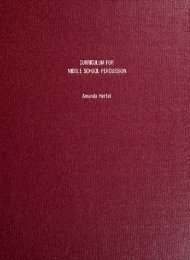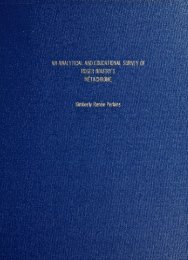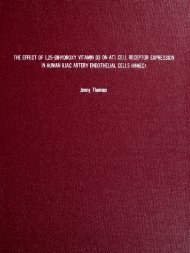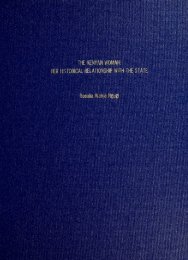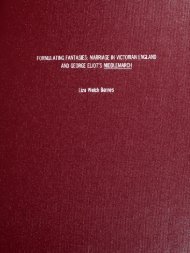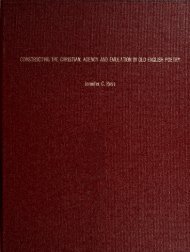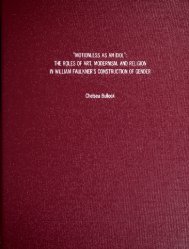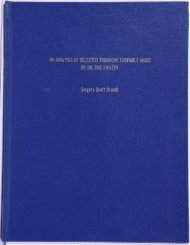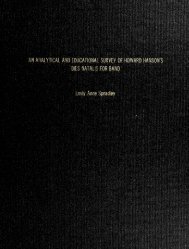Integrating Vocal and Musical Techniques - Columbus State University
Integrating Vocal and Musical Techniques - Columbus State University
Integrating Vocal and Musical Techniques - Columbus State University
Create successful ePaper yourself
Turn your PDF publications into a flip-book with our unique Google optimized e-Paper software.
Digitized by the Internet Archivein 2012 with funding fromLYRASIS Members <strong>and</strong> Sloan Foundationhttp://archive.org/details/integratingvocalOOrayf
<strong>Columbus</strong> <strong>State</strong> <strong>University</strong><strong>Integrating</strong> <strong>Vocal</strong> <strong>and</strong> <strong>Musical</strong> <strong>Techniques</strong>in the Choral RehearsalA Graduate Music Project Submitted in PartialFulfillment of the Requirements for theDegree of Master of Music in Music EducationWilliam W. Rayfield IIIMay 2007
The undergsigned, appointed by the Schwob School of Music at<strong>Columbus</strong> <strong>State</strong> <strong>University</strong>, have examined the Graduate Music Project titled<strong>Integrating</strong> <strong>Vocal</strong> <strong>and</strong> <strong>Musical</strong> <strong>Techniques</strong>in the Choral Rehearsalpresented by William W. Rayfield IIIa c<strong>and</strong>idate for the degree of Master of Music in Music Education<strong>and</strong> hereby certify that in their opinion it is worthy of acceptance.(Project Advisor) //
AbstractThe vocal warm-up is an aspect of the choral rehearsal which is many times seenas nothing more than a brief period in which a singer in an ensemble "warms''' his or hervocal mechanism in preparation for singing. It is also considered by many to be separatefrom the review of literature to be performed. However, if a conductor plans carefullyfor the warm-up period, it can serve to teach both vocal technique <strong>and</strong> the repertoire to bereviewed. There are numerous aspects of vocal technique that should be addressedduring the choral warm-up. Among these is posture, breath, intonation, resonance,extending the vocal range, <strong>and</strong> sight-singing. Also, aspects of the repertoire should beintroduced during this time. With careful planning, a conductor can teach proper vocaltechnique <strong>and</strong> introduce choral literature fairly quickly during the warm-up process.in
Table of ContentsAbstract i i iTable of Contents i vI. Introduction 2II. Body, Mind, <strong>and</strong> Voice 6III. Breath 12IV. Intonation 17V. Improving Resonance 20VI. Extending the <strong>Vocal</strong> Range 22VII. Sight-Singing as a Warm-Up 24VIII. Conclusion 25IX. Appendices 26A. Elementary Rehearsal Guides 26B. Middle School Rehearsal Guides 42C. High School Rehearsal Guides 56D. List of Repertoire 72E. Additional Resources 74X. Bibliography 76IV
It is not technique that is the essence of art, but the soul.As soon as the soul can communicate freely, without obstacles,a complete musical effect is created.Technique sufficient forfree manifestation of the child's soul can easily be masteredunder a good leader in any school.-Zoltan Kodaly-(Legany (ed.), 1975, as cited in Hassemann & Jordan, 1991, p.lj
I. IntroductionThere are literallyhundreds of things to take into consideration when planning achoral rehearsal. It seems that ensembles are always pressed for time in completingpreparation for concerts.There are even times when "perfecting" every aspect of a onehourprogram can seem like such a monumental task that we do not see the point in athorough warm-up routine.As a result, some directors may have the tendency at times torush through a series of monotonous, generic vocal exercises inorder to begin the "realrehearsal."fifaHffetmExample 1:"The Broken Triad"Anyone who has ever participated in a choral ensemble is undoubtedly familiarwith the above example. It is true that this exercise can be used as an important part of athorough warm-up routine; however, many times we see this as the routine itself.Eachmember of an ensemble prepares his or her voice for singing through mindless repetitionsof this exercise, but what puipose does it serve outside of that? What is learned in theprocess? Carl Eberhardt (1973) says in his book, A Practical Guide for ChoralRehearsals, that "choral directors do not sufficiently recognize the importance of generalvoice training <strong>and</strong> also of warming up" (p. 8). The choral warm-up is one of the mostvaluable parts of a rehearsal (Boyd, 1970, p. 103). It is not merely a cue for the
eginning of a rehearsal, but should be used as a way of teaching the literature to bereviewed <strong>and</strong> introducing choir members to proper vocal technique.According to James Jordan (2005), author of The Choral Warm-up: Methods,Procedures, Planning, <strong>and</strong> Core Exercises, there are two main points when considering achoral warm-up: what is the purpose for it, <strong>and</strong> what should be taught during it. Asmentioned above, time is always an issue. This being the case, I propose a third point:how does one conduct a thorough warm-up efficiently? The answer is, meticulousplanning."When the director is thoroughly prepared, the rehearsal will be better,the work will require less time to leam, <strong>and</strong> the result will be an artistic<strong>and</strong> secure performance.Remember that the choir must sufferthe consequences of each sin of omission on the part of the director."(Ehmann, 1968, as cited in Jordan, 2005, p. 206)The director must have a plan for every aspect of each rehearsal.Though therewill always be unforeseen problems that must be resolved, he or she must have an outlineof objectives to be achieved.This, first <strong>and</strong> foremost, requires that the director know therepertoire thoroughly (Lamb, 1974, p. 27).Assuming he has a comprehensive knowledgeof the music, he can develop a rehearsal guide that will assist in keeping the warm-upprocess well-organized <strong>and</strong> effective.The rehearsal guide should include everything thatwill take place during the rehearsal, including: the name of the works to be rehearsed, theorder inwhich those works will be reviewed, <strong>and</strong> the vocal <strong>and</strong> physical exercises thatwill be used during the warm-up.These guides should be extremely specific, includingeven the smallest details of the rehearsal.The following is an example of such a guide.
Name of work(s) to be rehearsedRehearsal DateGeneral Exercises'-'Exercises for Awakening the Mind <strong>and</strong>'-'Breathing: Exhalation, Inhalation <strong>and</strong>ImaginationSupport'-'Relaxation of BodyResonance <strong>and</strong> DynamicsnPosture'-'Five Pure Vowels (without diphthongs)DExp<strong>and</strong>ing the <strong>Vocal</strong> Tract'-'Finding Head Voice (yawn-sigh)'-'Relaxation of Jaw, Tongue <strong>and</strong> Lips'-'Range Extension <strong>and</strong> Register Consistency'-'Diaphragm Activity (also use to'-'Flexibility (runs)improve consonants)Exercises from Group <strong>Vocal</strong> Technique Cards (core exercises, can be filed on individual cards)Card Number:Specific ExercisesDExample 2: Rehearsal Guide(Haasemann & Jordan, 1991, p. 27)
There are numerous ways to outline a choral rehearsal. The above is merely anexample of a guide which has proved to be helpful to many directors.Any format maybe used, as long as itaids the director in transitioning smoothly throughout a rehearsal.There is no consensus on how long a thorough warm-up routine will be. It willdepend on a number of issues, one being the length of the rehearsal itself.The longer therehearsal is, the more time a director can spend on vocalises. S<strong>and</strong>ra Stegman (2003)states that "a brief, ten-minute warm-up period that is focused on prepajing chorusmembers to sing, listen,<strong>and</strong> leam establishes the direction of the rehearsal <strong>and</strong> furthersongoing vocal <strong>and</strong> musical development" (p. 1).
II.Body, Mind, <strong>and</strong> VoiceThe most effective choral rehearsals include warm-up routines that serve not onlyto prepare the voice to meet the dem<strong>and</strong>s of the literature to be reviewed <strong>and</strong> performed,but also to prepare the students' minds <strong>and</strong> bodies to recognize <strong>and</strong> produce desirablechoral tone.When preparing the voice, a director must promote proper vocal technique.This can be a difficult task when working with younger singers. The task is difficultbecause, in most cases (unless a student receives private voice lessons) v the choralrehearsal is the only place in which vocal instruction is given. Warming-up the mindrequires activities both physical <strong>and</strong> mental. Hopefully, these exercises will bring thestudents to a place where they are completely focused on the tasks at h<strong>and</strong>. This mustinclude a varied repertoire of vocalizes <strong>and</strong> discussion of aspects of the music to beperformed. Finally, the physical warm-up must address posture, relaxation, <strong>and</strong>, foryounger students, an excess of energy."Gymnastics <strong>and</strong> game sports should be encouraged, because theyproduce the flexibility <strong>and</strong> relaxation needed for singing."(Ehmann & Haasemann, 1981, p. 3)Physical exercises should be a part of every rehearsal.Ehmann <strong>and</strong> Hassemann(1981) state that physical activity promotes body awareness <strong>and</strong> body-mind coordination,<strong>and</strong> it also strengthens muscles needed for singing (p. 3). These exercises are especiallyimportant for students at the elementary level because they allow them to bum excessenergy <strong>and</strong> help them focus on the music.Though any type of movement will promote<strong>and</strong> require some flexibility,the following exercises, given by Ehmann <strong>and</strong> Hassemann(1981), may be helpful with younger groups:
.• Lay down <strong>and</strong> press the baek to the floor• Pair off the singers. The couples st<strong>and</strong> back to back, pressing at various pointsup <strong>and</strong> down the back.• Churning butter, crawling on all fours, rocking back <strong>and</strong> forth in a chair, playingleap frog, <strong>and</strong> playing dead (p. 3)Older groups however, (i.e.late middle school <strong>and</strong> high school singers) may appreciate amore subtle approach. For these ensembles, a director may choose to have the choirmembers turn to either side <strong>and</strong> massage the shoulders of the student infront of them.Older students may not have as much built-up energy as younger students, but they willdefinitely experience more stress <strong>and</strong> tension in the span of a day. A light <strong>and</strong> gentlemassage of the shoulders will more than likely be beneficial in ridding these students ofsuch problems. It also gives these older students a chance to meet new friends in theensemble or briefly converse with those friends they already have. Following theshoulder massage, a director can lead his or her ensemble in a number of stretches whichwill further its members flexibility <strong>and</strong> relaxation (Brinson, 1996, p. 129).Another aspect related to the physical warm-up is that of posture, which facilitatescorrect breathing <strong>and</strong> vocal production. This is of course something that is not instantlymastered by students, <strong>and</strong> will more than likely need to be attended to periodically duringa warm-up, as well as throughout a rehearsal.Webster's New World Dictionary of the American Language (1964) definesposture as "the position of the body <strong>and</strong> its parts." Directors throughout the worldconstantly address their ensembles' positioning by merely mentioning the word.However, there are some that suggest that the word should be ab<strong>and</strong>oned all together.
James Jordan (2005) considers the issue in his book, The Choral Warm-up: Method,Procedures, Planning <strong>and</strong> Core <strong>Vocal</strong> Exercises, saying that when students recall theirown ideas of good "posture," most of them are incorrect. He suggests using the term'alignment' instead (p. 39). In the human body, there are six points of alignment: thebase of the neck, the shoulders, the waist, the hips, the knees, <strong>and</strong> the ankles. Byaddressing each of these areas of the body, any misconceptions of alignment conducive togood singing can be corrected. There are a couple of approaches that can- be used inteaching correct alignment.Among these are "Body Mapping," which includes the abovementioned alignment points, <strong>and</strong> 'The Alex<strong>and</strong>er Technique."The Alex<strong>and</strong>er Technique was developed by nineteenth-century, stage actorFrederick Mathias Alex<strong>and</strong>er.During Alex<strong>and</strong>er's years on the stage, he found that hisvoice became hoarse easily <strong>and</strong> often.After numerous visits to various doctors proved tobe no help in diagnosing or solving his chronic condition, Alex<strong>and</strong>er began to experimentwith the way he delivered his lines. After years of experimentation, he concluded thatvoice quality was completely dependant upon the coordination of the entire body.Theconcept behind the Alex<strong>and</strong>er Technique is that every muscle in the body from head totoe must function in a specific manner. When the body is perfectly coordinated, all areasof performance, such as alignment <strong>and</strong> breathing, will benefit (Pawley, 2000, p. 1).Body Mapping, like the Alex<strong>and</strong>er Technique, deals with an individual'sperceptions of correct posture <strong>and</strong> how these perceptions are many times damaging toperformance. These misconceptions can lead to fatigue, vocal strain, as well as othertechnical, vocal problems.
These two approaches could not possibly be fully explained here, but there are anumber of sources available on the subject (see Additional Resources Appendix forsuggested reading). No matter the approach used, proper alignment should beencouraged by the director at all times, as it can contribute to proper breathing <strong>and</strong> vocalproduction.Because the scope of this volume is the choral warm-up, I will not address thephysical aspects of an entire rehearsal.However, physical gestures <strong>and</strong> movement can bevaluable inteaching a number of concepts throughout a rehearsal period <strong>and</strong> should notbe confined to the warm-up only."When students need to listen carefully <strong>and</strong> think about the new<strong>and</strong> varied exercises, they are likely to be more involved in theactivity <strong>and</strong> their minds will be challenged <strong>and</strong> focused."(Brinson, 1996, p. 129)In order to accomplish any musical task, a choir must be mentally prepared.Thewarm-up period of each rehearsal should be used as a means for this preparation. Imentioned in the introduction that many times the arpeggiated, major chord serves as thewarm-up for many choirs at every rehearsal. This, though it may be a quick way to"warm the voice," is detrimental to mental preparation. Singers have heard this repeatedpattern so many times that it requires no thought in order to participate. To avoid suchsituations, a director must vary the exercises used in daily warm-ups (Brinson, 1996, p.129). If the students do not know what is coming next, they will have to pay attention! If9
the choir is made to focus on the instructions of the director, less time will be wastedthroughout the rehearsal.This time of mental preparation may also include instruction of various musicalconcepts. For example, if a high school choir is to rehearse a piece written by JohannSebastian Bach, it may be beneficial to discuss the Baroque period <strong>and</strong> the specifictendencies of that composer.One must be careful though to include the ensemble in thediscussion <strong>and</strong> not bore its members with a lecture in music history. If the discussion isled in a manner that directly relates to the repertoire at h<strong>and</strong>, it will not only focus theensemble's attention, but intrigue them as well.A director should also make an effort todesign vocalizes that address specific difficulties in the repertoire <strong>and</strong> specific problemsthat the ensemble may be experiencing.Finally, mental preparation may be achieved through the use of sight-singingexercises. These can ensure that the participants are truly engaged in the rehearsalprocess.This will be discussed in more detail later."Choirs. ..can <strong>and</strong> should be provided with regularinstruction concerning the basic principles of vocal technique."(Hassemann & Jordan, 1991, p. 11)The choral warm-up must prepare not only themind <strong>and</strong> body for singing, butalso the vocal mechanism. Though this is obvious to all choral directors, the method orprocess needed to achieve such a task may not be so clear. It is also important to statethat this process should be used in order to teach good vocal technique for singing.If theonly concern was "warming" the vocal folds, then surely daily conversations that take10
place before a rehearsal would be sufficient. However, singing is a process that requiresspecial skills if done correctly. So, there must be a process of explaining <strong>and</strong> teachingthese skills. The process must be sequential, <strong>and</strong> based on foundational concepts. Manyof these foundational concepts are easily understood by the members of an ensemble ifpresented in a way that reflect life experience.Examples of this are yawning, crying, <strong>and</strong>laughing (Haaseman & Jordan, 1991, p. 11).Among this list of foundational concepts is breathing, intonation, resonance, <strong>and</strong>range extension (Haaseman & Jordan, 1991, p. 11).11
III. Breath"Because breathing is the basis for good singing,concentrated breath exercises are essential."(Ehmann & Haasemann, 1981, p. 5)Nearly every aspect of singing is controlled by the breath. If the members of anensemble do not have a thorough underst<strong>and</strong>ing of the breathing process, as well ascomplete control of that process, technical problems will surely be a result.Among thesemany technical problems are poor intonation, lack of resonance, <strong>and</strong> vocal strain.Though breathing is one of the most natural parts of life, there is still a need toaddress the issue in a choral warm-up. The reasoning behind this is that breathing forsinging is not the same as normal breathing in everyday life. James McKinney (1994),author of The Diagnosis <strong>and</strong> Correction of <strong>Vocal</strong> Faults, states that the essentialdifference between the two isthe amount of conscious control used during singing (p.46). Both inhalation <strong>and</strong> exhalation must be consciously controlled in order to achievebreath support that is advantageous to good tone.Until breathing for singing becomes asnatural as breathing in everyday life, it must be discussed during rehearsals in order toachieve a desired sound.To begin each rehearsal, many directors choose to use common exercises, such aslip trills, to improve or maintain proper breath support within their ensemble. Thisexercise allows a singer to focus on supporting a tone while facing resistance from twosources: the vocal folds <strong>and</strong> the lips. The process usually requires a vocalist to sing asimple progression of pitches (broken chords, etc.) or sustained tones while the lipsvibrate. This can be effective <strong>and</strong> time efficient. Even singers with relatively little choral12
experience are familiar with this exercise <strong>and</strong> can be expected to perform this taskwithout the director having to waste time on lengthy instructions.However, the exerciseis also limited in its range. As the pitches involved move into the ensemble's higherregisters, they will experience difficulty. Because their lips must touch, the singerscannot create sufficient space in the mouth for singing high pitches. This can cause thesound to become shrill. Other vocal issues of which a director must be aware whenimplementing lip trills in a rehearsal are: tension in the jaw, in the tongue, in the lips, <strong>and</strong>a raised larynx (Jordan, 2005, p. 72).eh}^^Dee doh dec doll dec dec dec dec dec dec dec dec dec dec3 e a r rp^=Example 3: "Upward Leaps on the Breath"(Shenenberger & Jordan, 2004, p. 3)The above exercise entitled Upward Leaps on the Breath isan exercise intendedto teach vocalists to sing "on the breath." "On the breath" is merely another way ofsaying breath support (Jordan, 2005, p. 63). The exercise features a rather slow tempo,large leaps, <strong>and</strong> a sustained, low pitch which will require the singers of an ensemble toclosely manage the amount of air used in each repetition. If the release of air is notcontrolled properly, it is likely that a singer will run out of air before completing theexercise. Another possibility is that the sustained tonic at the end of the exercise, maysag due to a lack of support. The exercise also alternates the syllables dee <strong>and</strong> doh. The13
singers will leap from the tonic {dee) to the dominant {doh). This pattern of alternatingsyllables facilitates a singer's need to create more space in the mouth by releasing thejaw.The concept of singing on the breath can be further communicated with theaddition of physical gesture. A director can ask his or her singers to place the left h<strong>and</strong>(palm up) at waist level. The right h<strong>and</strong> should be made into fist. In the tempo of theexercise, the student should move his or her right h<strong>and</strong> ina circular, "kneading" motion(down into the palm of the left h<strong>and</strong>). The size <strong>and</strong> speed of the circle should stayconsistent throughout the exercise. This can be used as a visual representation of theconstant flow of breath (Jordan, 2005, p. 65).This exercise can be used universally to emphasis the importance of breathsupport, however, itcan also be altered to relate specifically to the music being rehearsed<strong>and</strong> performed.For instance, the leaps at the beginning of the exercise can be changed tomatch prevalent intervals occurring in the repertoire to be reviewed in the rehearsal.Thisis also true of the syllables used. If there are words in a song's text that a director feelswill pose a problem to his or her ensemble, they can be substituted for the given syllablesdee <strong>and</strong> doh.One must be careful though to use open syllables for the higher pitches asnot to hinder the singers' ability to release their jaws.Another approach may be to have an ensemble take in a deep breath <strong>and</strong> releasethe air over a specified amount of time, using different consonants to stop the breathalong the way.14
J t J t J i »U U >U >U J *s f s f s f s fExample 4: Interrupted Breath Exercise(Eberhardt, 1973, p. 16)When doing this exercise, the singers must conserve the breath.This becomes amore difficult task when dynamics are considered. The louder the group rs asked toarticulate the "s" <strong>and</strong> "f ' consonants, the more their breath support will be tested. Afterseveral repetitions of this quick exercise, at various dynamic levels, singers shouldbecome aware of the importance of breath support at all dynamic levels.The above exercise can also be used with singers of all ages. Because it does notinvolve pitch, even the youngest choirs can experiment with variations of the interruptedbreath exercise with relative ease. One such variation is called "Hiss Till You Can't."This exercise demonstrates the difference in normal exhalation <strong>and</strong> exhaling over alonger period of time by having young singers hiss like a snake (Edwin, 2001, p. 49).Again, the importance of breath support at louder dynamics will be evident.A director ofyoung children must be careful to thoroughly explain the process <strong>and</strong> purpose for thechildren to truly benefit. These explanations will need to be quite specific, which willtake more time.However, after a few rehearsals, even young children should be able tocomplete several repetitions of this exercise fairly quickly.They will enjoy the challenge<strong>and</strong> friendly competition that comes with seeing who can hiss the longest.The examples given above are just a few of hundreds of exercises that can be usedto teach the importance of breath support or singing "on the breath." Though these15
exercises, in their original form, have proved valuable over the years, a director shouldfeel free to experiment with them, <strong>and</strong> make them more specific to the music theirensembles are reviewing.16
IV.Intonation"At the center of the ability to sing in tuneis the coordination of the ear <strong>and</strong> the voice."(Grant, 1987, p. 5)Intonation isdefined by Ehmann <strong>and</strong> Haaseman (1981) as "accuracy of tonality"(p. 137). The concept is simple enough- sing in tune! However, good intonation is anaspect of choral singing that is not easily achieved.Even the most successful choirs mustdiligently pursue good intonation on a daily basis. There are many factors that canprevent an ensemble from singing in tune including: lack of breath support, fatigue,inconsistent registration, improper vowel modification, <strong>and</strong> hearing deficiency (p. 137).No matter the cause of poor intonation, it is an issue that should be addressed in eachrehearsal.As mentioned above, one major contributor to poor intonation is a hearingdeficiency among members of a choir. If a singer cannot hear what is taking placearound him, he cannot possibly expect to sing in tune.The ability to hear <strong>and</strong> the abilityto sing are inseparable.The following are a few exercises that may be implemented in achoral warm-up to further a choir's ability to sing in tune.IE IE ie IE 331 IEillna.Example 5: Exercise for Intonation(Eberhardt, 1973, p. 11)17
As singers participate in the above exercise, they will be forced to listen intentlyto those around them.As they attempt to match the pitch, dynamic, color, <strong>and</strong> resonanceof their fellow choir members, the tone will eventually become more unified.Eberhardt(1973) compares the exercise to a piano being tuned. It is not until all three chords(above the assigned hammer) of a specific pitch are tuned alike that the desired sound isachieved.Resonance, dynamics, <strong>and</strong> color of tone among individual singers can best beunified by having them hum using the suggested consonant <strong>and</strong> vowel pattern (p. 11).Vowel production, another contributor to poor intonation, can also be addressedin a warm-up routine.To do so, the following is suggested:3EEEEmee. mch mah moh mooExample 6: Vowel Consistency, for Intonation(Brinson, 1996, p. 192)This exercise is designed to make the singers aware of the differences in vowelproduction between individual singers. It features a simple, melodic pattern of thirdswhich students from young to old should be able to sing after a short demonstration.Also, a director can instruct the ensemble on the correct pronunciation of the five purevowel sounds.If an ensemble is able to perform the above exercise with ease, a director maywant to go a step further by having the choir in four parts (SATB).18
'" S A—0—r—J——Jr rjj^4M- —p —-J-hr=p=moo moh mah meh4- jrmeeIIExample 7: SATB arrangement for Vowel Consistency(Brinson, 1996, p. 192)Though the intervals of the exercise have changed, the five pure vowels are stillrepresented. This will give the ensemble an opportunity to align their vowels, while atthe same time, paying attention to tone, breath, tempo, <strong>and</strong> resonance.19
V. Improving Resonance"...the end result of resonation is,or shouldbe, to make a better sound."(McKinney, 1994, p. 120)Assuming posture, breath, <strong>and</strong> intonation are allunder the control of an ensemble,the issue of resonance can then be settled. The resonating abilities of each individualvoice will differ greatly. Also, the methods by which each singer achieves a desiredamount of resonance will differ. However, choral resonance can be encouraged byexplaining to the singers how the vocal mechanism works <strong>and</strong> by using simple vocalexercises.It is common to hear voice teachers <strong>and</strong> choral directors say, "Feel it in themask."This refers to the vibrating sensation one gets in the sinus cavities when utilizingthe head voice. This sensation is usually a good indication that resonance is present intheir sound. Getting everyone to experience this sensation is relatively easy if the rightexercises, such as humming, are utilized. It is also beneficial to have a choir singsustained pitches while using nasal consonants (see example 5). If a choir is given dailyopportunities to experience the sensations common to good resonance, <strong>and</strong> the full soundthat hopefully accompanies it,the more comfortable they will be in producing a rich <strong>and</strong>warm sound.It is important to note that there are opinions about when best to instruct a choiron resonance. It is a step in the warm-up process that, if omitted, can hinder the entirerehearsal period that follows.Some have even been so specific as to say resonating20
exercises must take place directly after breathing exercises (Jordan, 2005, p. 73).21
VI.Extending the <strong>Vocal</strong> Range"Singing in the upper range is an acquired skill.The vocaltechnique required must be built over a long period of time."(Jordan, 2005, p. 93)As the vocal dem<strong>and</strong>s of a choir's repertoire grow, there will atsome point be aneed to work on extending the vocal range of the ensemble.As Jordan states in the quoteabove, singing in the upper register is an acquired skill. This is also true of the lowerextremes of the range. The process of extending the vocal range, both high <strong>and</strong> low,must be h<strong>and</strong>led carefully to avoid technical problems <strong>and</strong> possible harm to the vocalmechanism.When extending the range upward, the larynx will have the tendency to rise withthe pitch. Because of this, it is better to begin vocal exercises within the comfortablerange of the singers before working up to the extremes.This can easily be done througha number of other exercises, even those designed to address other aspects of singing.After the voice is ready to be tested, vocal exercises that focus on the area just above thechoir's middle register should be used. This area will differ between individual voices<strong>and</strong> choirs as a whole, but usually itwill be between C <strong>and</strong> E for high voices <strong>and</strong> betweenG <strong>and</strong> B for low voices. The sound produced in this register can generally becharacterized as "softer <strong>and</strong> more buoyant" (Robinson, 1977, p. 12). The following is anexercise that focuses on these elements:22
Example 8: Range Extension(Shenenberger & Jordan, 2004, p. 4)As you can see, the exercise features a melody that begins well within the middle(if not lower) range of the singers. The second measure is simply an arpeggiated tonicchord (do-mi-sol-do-sol-mi-do) with a triplet rhythm. As simple as the passage is, it isperfect for extending the range upward. The leap from sol to high do in measure tworequires the singers to move out of the middle register while keeping the tone consistentwith that of the previous measure.As with other exercises shown, the syllables given areconducive to the space needed to sing higher pitches.After several repetitions, movingup by half step each time, the choir members will be prepared to sing in their higherregisters without straining.All of the above can also be applied to the extension of the vocal rangedownward.However, when using descending melodic patterns as warm-ups, the directormust be careful in making sure that the choir's placement remains high. Also the choirmembers should be encouraged to utilize head tone in their lower range as much aspossible (Jordan, 2005, p. 93).23
VII.Sight-Singing as a Warm-Up"Sight-singing skills, like vocal techniques, are asmuch a part of the training of singers as are therehearsing of pieces to be performed....(Brinson, 1996, p. 131)Teaching a student to sight-sing is of the utmost importance, unfortunately, it isalso difficult <strong>and</strong> time consuming. Because the process is often long <strong>and</strong> complicated, adirector may be tempted to leave it out of a choir's daily routine. This is a terriblemistake.If singers are never taught to read music they will be reduced to learning everysong in their repertoire by rote. However, if a director is willing to spend the timenecessary to teach this invaluable skill, he or she will find that the ensemble will actuallysave time in the long run.There are many different ways to incorporate sight-singing into a choral warm-up.Some instructors choose to write their own exercises that feature various melodic patterns<strong>and</strong> intervals. Others may choose to use familiar folk songs or church hymnals. Stillanother option would be to introduce a new piece as the exercise itself.This can be achallenging <strong>and</strong> efficient way to incorporate sight-singing in a warm-up.As music educators, our firstresponsibility should be teaching our students theconcepts needed to become musically literate.By using sight-singing exercises as a partof an ensemble's daily routine, we can be sure that they are well on their way.24
VIII.ConclusionThe choral warm-up is a process that prepares the members of an ensemblementally, physically, <strong>and</strong> vocally. Because there are so many aspects of a singer'sdevelopment that must be addressed during a warm-up period, it can at times be a timeconsuming process. However, through the meticulous planning of the conductor, thechoral warm-up can be both efficient <strong>and</strong> enjoyable for allsingers.Among the aspects to be addressed during a choral warm-up are:breath support,intonation, developing resonance, extending the vocal range, <strong>and</strong> sight-singing.Addressing each of these issues may seem to be a monumental task when considering thehectic performance schedules of many choirs, but they are necessary if we are to achievea desired sound from a choir.If choral directors will take the time to teach the necessary skills for good vocalproduction we will surely find that it is worth the effort. We will find that our singers arenot only capable of making beautiful music, but they are on the road to becoming welltrained,musically literate individuals.25
Appendix A:Elementary Rehearsal Guides26
Name of work(s) to be rehearsedDanny Boy- Ruth Elaine Schram, BriLee Music Publishing Co.General ExercisesXXDExercises for Awakening the Mind <strong>and</strong>ImaginationRelaxation of BodyPosture"W^Breathing: Exhalation, Inhalation <strong>and</strong>SupportResonance <strong>and</strong> DynamicsFive Pure Vowels (without diphthongs)'-'Exp<strong>and</strong>ing the <strong>Vocal</strong> TractXFinding Head Voice (yawn-sigh)^Relaxation of Jaw, Tongue <strong>and</strong> Lips^Range Extension <strong>and</strong> Register ConsistencynDiaphragm Activity (also use to1=1Flexibility (runs)improve consonants)• Various Stretches, physical movement• "Siren" {"oo")• Sight Singing, introduce melodyoSolfege <strong>and</strong> H<strong>and</strong> SignsSpecific ExercisesXMajor ScaleD27
m,
Specific Exercises:The above exercise (Exercise 1) is simply a major scale to be sung in unison bythe choir on the syllable "loo"This will more than likely be a st<strong>and</strong>ard exercise that iseasily executed by upper-elementary aged children. By adding a crescendo to theascending line, the students will be able to maintain a beautiful, full tone in their upperregisters.This directly relates to the repertoire as the dynamic level should grow as themelodic line rises.Though there are only a few exercises given above, they should serve tothoroughly prepare a young ensemble to rehearse Schram's piece for unison voices,Danny Boy. Considering the age of the students (between third <strong>and</strong> fifth grade), it will bea quick yet challenging routine.29
Name of work(s) to be rehearsedHow Can I Keep From Singing, Ginger Littleton, BriLeePublishing Co.General ExercisesX Exercises for Awakening the Mind <strong>and</strong>ImaginationXBreathing: Exhalation, Inhalation <strong>and</strong>Support'-'Relaxation of Bodyl-1Resonance <strong>and</strong> DynamicsaPosture^Five Pure Vowels (without diphthongs)1=1Exp<strong>and</strong>ing the <strong>Vocal</strong> TractXFinding Head Voice (yawn-sigh)'-'Relaxation of Jaw, Tongue <strong>and</strong> Lips'-'Range Extension <strong>and</strong> Register Consistency'-,Diaphragm Activity (also use toimprove consonants)*-*Flexibility (runs)• Improvisation with Orff instruments• "Siren"{y'oo")• "Hiss Till You Can't"Specific ExercisesX Pentatonic Scale30
Do re mi sol la sol mi re doExercise 1:Pentatonic ScaleGeneral Exercises:The melody of the Quaker tune. How Can I Keep from Singing, isbased on thepentatonic scale. This alone offers a number of warm-up possibilities. For instance, anelementary school choir director may choose to have his or her choir improvise oncommon Orff instruments such as the xylophone.This serves not only as a good physicalactivity for the students, but also to introduce the choir to the pentatonic scale.However,this exercise must be carefully planned.If the instruments are not prepared (in place withunneeded bars removed) the exercise will take a great deal of time. It is best to have thisat the beginning of the warm-up as not to waste valuable time moving equipment.Again, the vocal "siren," on the syllable "00," is used to aid in finding the headvoice.Students should be given the chance to experience the vocal freedom of yawning,sighing, <strong>and</strong> imitating a siren. It also gives them a chance to release some energy beforerehearsing the repertoire.Finally, the ensemble should be made aware of the importance of breath.Finishing the rather long phrases featured in How Can I Keep from Singing could beextremely difficult for a young singer if attention is not paid to breath support. By usingthe "Hiss Till You Can't" exercise, the students will become more familiar with theconcept of breath support.They should also be asked to "hiss" at various dynamic levels31
to gain underst<strong>and</strong>ing of the differences between breathing for fortissimo <strong>and</strong> pianissimosinging.Specific Exercises:After the students experience the pentatonic scale by playing the related pitcheson the xylophone, they can then be asked to sing the scale in unison (see Example 1above). The tonality will then be more evident. Solfege can be used along with theaccompanying h<strong>and</strong> signs.The exercise may also be performed using the "00" syllable.Using "00," the students will have to release the jaw creating sufficient space for properpronunciation of the syllable. Also, the rounded shape of the lips will assist in keepingthe tone warm.Littleton includes performance notes for How Can I Keep from Sitiging.These notes support the need for slight crescendo as the melodic line ascends.This canbe easily incorporated inthe pentatonic scale exercise by having the choir members singlouder on the way up the scale <strong>and</strong> softer on the way down.32
Name of work(s) to be rehearsedFare You Well- Ruth Elaine Schram, BriLee Music PublishingCo.General ExercisesX Exercises for Awakening the Mind <strong>and</strong>^ImaginationRelaxation of BodyX'-'Breathing: Exhalation, Inhalation <strong>and</strong>SupportResonance <strong>and</strong> Dynamics^Posture'-'Five Pure Vowels (without diphthongs)DExp<strong>and</strong>ing the <strong>Vocal</strong> TractXFinding Head Voice (yawn-sigh)'-'Relaxation of Jaw, Tongue <strong>and</strong> Lips'-'Range Extension <strong>and</strong> Register Consistency^Diaphragm Activity (also use to'-'Flexibility (runs)improve consonants)• Rubato, Game• Breath Exercise, Unison "la'• "Siren" (uoo")Specific ExercisesX Arpeggiated Chord (Major) DXaOctave Leapsaa33
i ri"ifMrMlifeee eh ah oh oo. ee eh ah oh oo.Exercise 1:Arpeggiated Chord|I*yy||'W tlfatI r*'I9-jee ah ee aheeahExercise 2: Octave LeapsGeneral Exercises:The general exercises listed for Fare You Well by Ruth Elaine Schram, include agame to teach the concept of rubato, a breathing exercise, <strong>and</strong> the vocal "siren."The rubato activity should be used to teach the students that a steady beat (whichis taught on a daily basis in the elementary classroom) may at times, slow down or speedup. The instructor should emphasize the importance of watching the conductor. The ideaof the game is simple. In unison, the young ensemble should sing even quarter notes thatreflect the conductor's gestures (clapping, conducting, etc.).After a steady beat has beenestablished, the conductor should begin to make his or her gestures faster or slower.Thiswill ensure that the students are aware that the tempo may fluctuate throughout the piece.Also, the singers will see the importance of focusing on the conductor.To make certain34
that the students are indeed watching, audible cues such as clapping <strong>and</strong> snapping maywant to be avoided.The breathing exercise mentioned above should be done to make the studentsaware of breath support <strong>and</strong> phrase length.The students should be asked to sing togetherin unison. The instructor can then indicate dynamic changes through gestures or verbalcues.One might consider having the ensemble hold this pitch at a specific dynamic levelfor the duration of a majority of the phrases in Fare You Well (four measures). „The "siren" has been previously explained above, <strong>and</strong> will not be furtherexplained here.Specific Exercises:The arpeggiated chord (Exercise 1) should be used first so that the students canexperience the tonality of the piece to be rehearsed. It will also introduce the openingphrase of the piece as it is simply an arpeggiated chord (this pattern repeats with eachverse).Following the above exercise, should be a series of octave leaps (Exercise 2).Keeping a desirable tone during this exercise <strong>and</strong> tuning the interval involved will bechallenging for students of this age, so the expectations of the director must be carefullyexplained. Because the octave leap is a prevalent interval in the melody of Fare YouWell, this exercise, if done carefully, should benefit both the students <strong>and</strong> the rehearsalperiod.35
Name of work(s) to be rehearsedMay the Road Rise to Meet You- Ruth Elaine Schram, BriLeePublishing Co.General ExercisesXXExercises for Awakening the Mind <strong>and</strong>ImaginationRelaxation of Body'-''-'Breathing: Exhalation, Inhalation <strong>and</strong>SupportResonance <strong>and</strong> Dynamics'-'Posture'-'Five Pure Vowels (without diphthongs)'-'Exp<strong>and</strong>ing the <strong>Vocal</strong> TractXFinding Head Voice (yawn-sigh)'-'Relaxation of Jaw, Tongue <strong>and</strong> Lips'-'Range Extension <strong>and</strong> Register Consistency'-'Diaphragm Activity (also use toFlexibility (runs)improve consonants)Stretches,Physical Movemento Trace Phrases Throughout Warm-upSight-Singing, Follow H<strong>and</strong> Signs of DirectorSpecific ExercisesX Arpeggiated Chord 1-3-5-1X "Legato at a Slow Tempo"36
§feee eh ah oh oo. cc eh ah oh oo.Exercise 1: Arpeggiated Chord, 1-3-5-1Anoo noo noo noo noo noo nooExercise 2: "Legato at a Slow Tempo"(Shenenberger & Jordan, 2004, p. 1)General Exercises:A series of stretches will be done at the beginning of the warm-up process.Thiswill give the students an opportunity to loosen up muscles <strong>and</strong> bum a bit of energy after along day of sitting still in a desk. There is no set routine for this process, but it is wise toinstruct the members of the ensemble to focus on the joints in the body (i.e. wrists,elbows, neck, shoulders, etc.). Whatever the stretch being used, it may be beneficial todemonstrate it for the singers. This will help the students to avoid any injuries due toover extending any joint or muscle.Another physical activity from which the young singer can profit is tracingphrases with their fingers.A melodic pattern can be introduced, <strong>and</strong> after demonstratingthe process, the students can follow the phrase helping them to internalize its contour.It37
will also be a visual aid to help the students avoid accenting notes involved in largerleaps.Since the melody of May the Road Rise to Meet You by Ruth Elaine Schram,moves by step in most cases, it may be possible to introduce the melody with a sightsingingexercise.The director can introduce the melody by using Kodaly h<strong>and</strong> signs <strong>and</strong>having the students sing the corresponding pitches.This will of course take time, but itwill greatly benefit the singers in the learning process. This can also be- a possiblemethod of assessment for the teacher.Specific Exercises:May the Road Rise to Meet You is a piece in which the choir is asked to singlegato. This can be addressed using Exercise 1. When doing this exercise, the singersmust be told that the leaps in the vocal line, especially that of sol to do must be smooth.Again, tracing the melody with the finger may be helpful in this exercise.To further emphasize the legato line, one can use the "Legato ata Slow Tempo"exercise (Exercise 2)suggested by Marilyn Shernenberger <strong>and</strong> James Jordan (2004) intheir book, The Choral Warm-up, Core <strong>Vocal</strong> Exercises.Though the exercise is intendedfor older singers, it is not difficult technically. If explained in the right way, the exercisecan be advantageous in the elementary choir rehearsal.38
Name of work(s) to be rehearsedKyrie Eleison- Sonja Poorman, BriLee Music Publishing Co.General Exercises^ Exercises for Awakening the Mind <strong>and</strong>ImaginationXBreathing: Exhalation, Inhalation <strong>and</strong>SupportRelaxation of Body"-1Resonance <strong>and</strong> DynamicsPosture'-'Five Pure Vowels (without diphthongs)aExp<strong>and</strong>ing the <strong>Vocal</strong> TractXFinding Head Voice (yawn-sigh)DRelaxation of Jaw, Tongue <strong>and</strong> Lips'-'Range Extension <strong>and</strong> Register ConsistencyaDiaphragm Activity (also use to'-'Flexibility (runs)improve consonants)• "Siren"• "Hiss Till You Can't"Specific ExercisesX "Legato at a Slow Tempo"X Arpeggiated Chord 1-3-5-1D39
ee eh ah oh oo. ee eh ah oh oo.Exercise 1: Arpeggiated chord, 1-3-5-1Unnoo noo noo noo noo noo nooExercise 2: "Legato at a Slow Tempo"(Shenenberger & Jordan, 2004, p. 1 )General Exercises:The general exercises that begin the rehearsal of Kyrie Eleison by Sonja Poorman,are the "siren" <strong>and</strong> "Hiss Till You Can't." Both have been explained previously <strong>and</strong>require no further explanation here.Specific Exercises:Poorman's setting of Kyrie Eleison calls for a legato line. This legato is not onlysuggested by the text, but also suggested in the tempo marking, Gentle <strong>and</strong> Flowing.Toensure that the students fully comprehend the concept of legato, itshould be addressed inthe warm-up routine.The arpeggiated, major chord (Example 1) will give the singers theopportunity to experience a legato line while singing leaps of thirds <strong>and</strong> fourths. Thisexercise will also familiarize the students with bits <strong>and</strong> pieces of the repertoire as eachphrase begins with a major triad in first inversion. Because the text is in Latin, it may be40
a good idea to have the ensemble do this exercise using the five pure vowels.This willcreate an opportunity to explain the text <strong>and</strong> how carefully itmust be pronounced."Legato ata Slow Tempo," may also be used to further the discussion of legato.Again, the director's expectations should be given.Demonstrations will also be helpfulin using this exercise41
Appendix B:Middle School Rehearsal Guides42
Name of work(s) to be rehearsedHow Old Do Ya ' Have To Be To Sing the Blues- Russ Robinson,Galleria PressGeneral ExercisesXXExercises for Awakening the Mind <strong>and</strong>ImaginationRelaxation of Body^Breathing: Exhalation, Inhalation <strong>and</strong>SupportResonance <strong>and</strong> DynamicsPosture'-'Five Pure Vowels (without diphthongs)'-'Exp<strong>and</strong>ing the <strong>Vocal</strong> Tract1=1Finding Head Voice (yawn-sigh)Relaxation of Jaw, Tongue <strong>and</strong> Lips'-'Range Extension <strong>and</strong> Register ConsistencyDDiaphragm Activity (also use to'-'Flexibility (runs)improve consonants)JazzoDiscussionRhythmic QualitiesIncorporate Movement, Swaying to Jazz RhythmSpecific ExercisesX 5-1, Blues RhythmX Arpeggiated Triad (major) D43
IiifHTTirDoo ba doo ba dooDoo ba doo ba dooExercise 1:5-1, with blues swingi%k$ Bi*\hDoo ba doo ba doo Doo ba doo ba dooExercise 2: Arpeggiated Triad (major)General Exercises:The general exercises involved in preparation to rehearse How Old Do Ya' HaveTo Be To Sing The Blues by Russ Robinson, include discussing the characteristics ofblues <strong>and</strong> jazz, swinging rhythm, <strong>and</strong> movement for further underst<strong>and</strong>ing. The piececalls for a swinging rhythm which must be explained if the singers are to underst<strong>and</strong> thewritten music. Furthermore, the singers should be asked to move (i.e. sway, clap, etc.) ina manner that reflects the rhythmic characteristics of the piece.This will serve in keepingthe students 1attention, as well as giving them an opportunity to get out of their seats <strong>and</strong>move.Specific Exercises:The two vocalises seen above (the arpeggiated major chord <strong>and</strong> walking down thescale from 5 to 1) are easily executed by students of this age. They have heard themmany times before, however they are made much more interesting when the swinging44
hythm is incorporated. By taking a familiar exercise (which will save time) <strong>and</strong>integrating a new element such as swinging rhythm, the students willnot be as likely tolose interest.The simplicity of the pitches will allow the singers to focus on the rhythmicqualities of the exercises. It may be effective to carry out these exercises using thesyllables doo-ba as they are common throughout How Old Do Ya' Have To Be To SingThe Blues.45
Name of work(s) to be rehearsedH<strong>and</strong>xn H<strong>and</strong>- Arr . DickAverre, Belwin Mills Publishing Co.General ExercisesX Exercises for Awakening the Mind <strong>and</strong>ImaginationRelaxation of BodyX^Breathing: Exhalation, Inhalation <strong>and</strong>SupportResonance <strong>and</strong> DynamicsDPosture'-'Five Pure Vowels (without diphthongs)'-'Exp<strong>and</strong>ing the <strong>Vocal</strong> Tract'-'Finding Head Voice (yawn-sigh)Relaxation of Jaw, Tongue <strong>and</strong> Lips^Range Extension <strong>and</strong> Register ConsistencyDiaphragm Activity (also use to'-'Flexibility (runs)improve consonants)• Game, Identify the MeterSpecific ExercisesX Third Leaps (solfegeX 1-5 (Humming)46
* ^rdo mi re fa mi sol fa re do3^Exercise 1:Third Leaps, (solfege)%k$I H'Yfl J JHmm.HmmExercise 2: 5-1, hummingGeneral Exercises:To break the monotony of day-to-day warm-up routines, it is a good idea toprepare the minds of younger singers with something more than triads <strong>and</strong> other repeatedpatterns. H<strong>and</strong> In H<strong>and</strong> arranged by Dick Averre lends itself to such activities byutilizing meter changes before each phrase. Though these meter changes do notsignificantly effect the vocal lines, it is a great opportunity to teach yet another aspect ofmusic. A simple game can be developed to have students identify <strong>and</strong> demonstratechanging meters. When the director is satisfied that the students underst<strong>and</strong> the conceptof changing meters, he or she may then proceed in the warm-up routine.Form can alsobe discussed at this point as the meter changes indicate the onset of a number of phrases.Specific Exercises:The group vocalises shown above are good way to prepare the voice for thispiece. The first, suggested by Barbara Brinson (1996, p. 192), can be used for its47
similarity to the melody.Because the melody of H<strong>and</strong> in H<strong>and</strong> features a number ofthirds, it will benefit the students by hearing this particular interval.Finally, the students humming pitches (from scale degree 5 to scale degree 1) willallow the students to experience a feeling of resonance in their voice. It should be easy tomaintain the placement of the sound since the ranges of the vocal lines are fairly narrow.48
-Name of work(s) to be rehearsed1. Should Fancy Cease (from Three Canons for Voice)Vincent Persichetti, Elkan-Vogel Inc.General Exercises'-'Exercises for Awakening the Mind <strong>and</strong>'-'Breathing: Exhalation, Inhalation <strong>and</strong>ImaginationSupportXRelaxation of Body1=1Resonance <strong>and</strong> DynamicsXPosture*-'Five Pure Vowels (without diphthongs)I-1Exp<strong>and</strong>ing the <strong>Vocal</strong> TractXFinding Head Voice (yawn-sigh)'-'Relaxation of Jaw, Tongue <strong>and</strong> LipsDRange Extension <strong>and</strong> Register ConsistencyDiaphragm Activity (also use to'-'Flexibility (runs)improve consonants)VariousStretcheso Address Posture"Siren"Specific ExercisesX Arpeggiated Triad (minor^XOctave Leaps49
General Exercises:One physical activity not yet discussed is discussing <strong>and</strong> establishing goodposture. This is an aspect of singing that should be emphasized frequently to anensemble of this age. I only mention it here because of the moderately dem<strong>and</strong>ing rangeof the theme featured in Persichetti's Should Fancy Cease.If good posture <strong>and</strong> sufficientbreath support are not used by the singers, the tone will surely be lacking in quality.Specific Exercises:Because the arpeggiated triad <strong>and</strong> octave leap exercises have been shown <strong>and</strong>discussed previously, I will not list them again here. However, I will mention that thearpeggiated triad should be in the minor mode to reflect the tonality of the piece.Also,the onset of the theme is a perfect octave which justifies the following octave leapexercise.The syllables "oo" <strong>and</strong> "ah" should be used during the octave leap exercise.This not only allows the students to create sufficient space in their mouths, but it alsodirectly relates to the text of the piece.50
Name of work(s) to be rehearsed2. Preface to Canons (from Three Canons for Voice)Vincent Persichetti, Elkan-Vogel Inc.General ExercisesX Exercises for Awakening the Mind <strong>and</strong>^^ImaginationRelaxation of BodyPostureX'-'1=1Breathing: Exhalation, Inhalation <strong>and</strong>SupportResonance <strong>and</strong> DynamicsFive Pure Vowels (without diphthongs)'-'Exp<strong>and</strong>ing the <strong>Vocal</strong> TractnFinding Head Voice (yawn-sigh)'-'Relaxation of Jaw, Tongue <strong>and</strong> Lips'-'Range Extension <strong>and</strong> Register ConsistencyDiaphragm Activity (also use to'-,Flexibility (runs)improve consonants)• Discuss Texto Discussion of Form• Sight-singing, melody (using solfege!• "Hiss Till You Can't"Specific ExercisesX "Upward Leaps on Breath. .D."D51
fczfp^p-s>-Dec doh dec doli dec dec dec dec dec dec dec dec dec dec\\y :Ai' \\^ir p p"Upward Leaps on the Breath, with Line"(Shenenberger & Jordan, 2004, p. 3)General Exercises:The text of Persichettfs Preface to Canons written by Herman Reichenbach, isaperfect way to both introduce the form of the piece as well as the methods of rehearsingit.The following is the text of the piece:'The primary element of a canon is not the scorebut the melody. The canonic setting should not betried before the melody is completely mastered.It isdeplorable if a piano is necessary for studying the tune:itis entirely out of the question to use the piano forthe polyphonic set-up. This has to be done a cappella. ,,(Persichetti, 1947, p. 4-5)This text can be used to challenge to the students. The challenge is to learn the melodywithout the use of piano accompaniment. Hopefully, this will motivate the students toput forth their best efforts in the following sight-singing exercise. Solfege syllablesshould be used to further facilitate the students in the process. This exercise must becarefully planned if itis to move quickly <strong>and</strong> without trouble.52
"Hiss Till You Can't" will serve in once again reminding the students of properbreath support. This support will be needed in the fast-paced, relentless eighth notesfeatured in the piece.Specific Exercises:"Upward leaps on the breath, with line,"suggested by Shenenberger <strong>and</strong> Jordan(2004) will further emphasize breath support (p. 3). The kneading motions ..mentionedabove (III.Breath) may be incorporated as visual representation of the movement of thebreath.53
Name of work(s) to be rehearsed3. Hallelujah, Bum Again (from Three Canons for Voice)Vincent Persichetti , Elkan-Vogel Inc.General Exercises'-'Exercises for Awakening the Mind <strong>and</strong>XBreathing: Exhalation, Inhalation <strong>and</strong>ImaginationSupport*-*Relaxation of Body'-'Resonance <strong>and</strong> Dynamics'-'Posture'-'Five Pure Vowels (without diphthongs)DExp<strong>and</strong>ing the <strong>Vocal</strong> Tract'-'Finding Head Voice (yawn-sigh)Relaxation of Jaw, Tongue <strong>and</strong> Lips'-'Range Extension <strong>and</strong> Register ConsistencynDiaphragm Activity (also use to'-'Flexibility (runs)improve consonants)"TheCall"Specific ExercisesX Minor Scale (raised 6)DD54
General Exercises:The genera] exercises selected for this particular warm-up are the "call" <strong>and</strong> abreath exercise featuring dynamic contrasts. Because the third installment ofPersichetti's Three Voices for Canon, Hallelujah, Bum Again, features enormouscontrasts in dynamic levels (pp tofff), itwill be beneficial to have the singers call loudly.Because calling is a natural part of life, proper support is naturally used (Hasseman &Jordan, 1991, p. 44). When this concept is learned by the students, they can then transferthat knowledge to the musical setting.'Taught correctly <strong>and</strong> used correctly, the call canserve as a vehicle for forte singing..."(Hasseman & Jordan, 1991, p. 44).Specific Exercises:The melody of the canon isin the minor mode <strong>and</strong> features a reoccurring raisedsix scale degree.Addressing this in a warm-up routine can be done easily by having thechoir sing a minor scale on the syllable "oo."When this is done to the satisfaction of thedirector, he or she can then explain the raised sixth scale degree <strong>and</strong> have the ensemblethen observe it in following repetitions. This will be difficult for the group, but withthorough explanations <strong>and</strong> demonstrations, they should be able to experience somesuccess.55
Appendix C:High School Rehearsal Guides56
Name of work(s) to be rehearsedHow Can I Keep From Singing- Z. R<strong>and</strong>all Stroope,Alliance Music PublicationsGeneral ExercisesnExercises for Awakening the Mind <strong>and</strong>ImaginationRelaxation of Body'-'XBreathing: Exhalation, Inhalation <strong>and</strong>SupportResonance <strong>and</strong> DynamicsPosture'-'Five Pure Vowels (without diphthongs)DXExp<strong>and</strong>ing the <strong>Vocal</strong> TractRelaxation of Jaw, Tongue <strong>and</strong> LipsXXFinding Head Voice (yawn-sigh)Range Extension <strong>and</strong> Register ConsistencyDiaphragm Activity (also use toFlexibility (runs)improve consonants)• Resonance: Humming, Various Patterns (Triads)"Siren, " Yawn, SighSpecific ExercisesX "Range Extension Upward" DX "Legato Line" D57
1&—mdec dec dec dee dec dec dec dec dec dec dohExercise 1 : "RangeExtension Upward"(Shenenberger <strong>and</strong> Jordan, 2004, p. 3)yi\>/!L \y >\&\ > f-W- 6 —
Specific Exercises:The vocal lines of Stroope's composition can be quite dem<strong>and</strong>ing for singers ofthis age. Many of the voices (especially the first tenors) spend a great deal of time intheir upper registers. This being the case, a director may consider using some rangeextension exercises to prepare them for such occasions.As seen above, the exercise titled"Range Extension Upward" will be useful inworking the upper registers of the students,preparing them for these higher pitches.Also, the change from dee to doh wilJ allow formore space as they leap from the dominant up to the tonic.The final exercise, "Legato Line," will, as with previous pieces, prepare theensemble for the legato lines required in How Can I Keep From Singing.59
Name of work(s) to be rehearsedIrish Prayer- Doug Andrews, Hal Leonard CorporationGeneral ExercisesnExercises for Awakening the Mind <strong>and</strong>XImaginationRelaxation of BodyX'-'Breathing: Exhalation, Inhalation <strong>and</strong>SupportResonance <strong>and</strong> Dynamics*-*Posture'-'Five Pure Vowels (without diphthongs)DExp<strong>and</strong>ing the <strong>Vocal</strong> TractXFinding Head Voice (yawn-sigh)^Relaxation of Jaw, Tongue <strong>and</strong> LipsXRange Extension <strong>and</strong> Register ConsistencynDiaphragm Activity (also use to'-'Flexibility (runs)improve consonants)Physical Warm-upo Various Stretches, Light Massage of ShouldersBreath: (Eberhardt, 1973, p. 16)4 J lJ IitI » i |i iIJ -h-4-s f s t s 1 sSpecific ExercisesX "Repeated Tone with Cresc/Decresc" ^X "Legato at Slow Tempo" nX Major Chord (SATB) D60
iii.V-__/j j j jj j j jj j j jMcc. Meh. Mali. Mohjjtjtj jT-j;Moo.Exercise 1:Repeated Tone with Crescendo <strong>and</strong> Decrescendo(Shenenberg & Jordan, 2004, p. 1)3=ZE ZQI JCHMoo Moh MaliS-o- -o- -o-Moo Moh MaliS -o- -o- -©-^^MooMohmMaliXEMoo Moh MaliExercise 2: Major Chord, SATBGeneral Exercises:A routine of physical warm-ups <strong>and</strong> stretches should be performed before singingbegins in the rehearsal.This will aid in relaxing the students during or after a long day ofclasses. Following the physical activities, selected breath exercises will need to becarried out. This attention to breath support is extremely important when consideringDoug Andrew's Irish Prayer due its long phrases. The breath exercise listed in therehearsal guide above, suggested by Eberhardt (1973), will help in establishing breath61
support throughout the ensemble (p. 16). Alternating the consonants s <strong>and</strong> / duringexhalation should test the control of breath for each student.A predetermined number ofrepetitions should be established before beginning the exercise so that the students canmanage their exhalation accordingly.Specific Exercises:The vocalises chosen above will address breath support, legato line, <strong>and</strong>intonation. The first exercise, "Repeated tone with crescendo <strong>and</strong> decrescendo" willfurther the students underst<strong>and</strong>ing of breath support (Shenenberger & Jordan, 2004, p. 1).Adding the element of crescendo <strong>and</strong> decrescendo makes the process more challenging.The students may need brief coaching in order to find success in the exercise. Thesecond exercise, "Legato at a slow tempo" (Shenenberger & Jordan, 2004, p.1) will givethe students a chance to experience the legato needed in the piece.Finally, the major chord in four parts can be used as a listening activity as muchas a vocal warm-up.The students should be asked to pay close attention to the soundaround them.This will certain enable them to tune any problematic intervals within thechord. It is also possible to have the sections (SATB) move up <strong>and</strong> down in pitch,creating new chords with contrasting values. This will test their ears as they proceedthrough the exercise.62
Name of work(s) to be rehearsedScaramella- Josquin des Pres, Fostco Music CoGeneral ExercisesX Exercises for Awakening the Mind <strong>and</strong>ImaginationRelaxation of BodyX^Breathing: Exhalation, Inhalation <strong>and</strong>SupportResonance <strong>and</strong> DynamicsDPostureXFive Pure Vowels (without diphthongs)^Exp<strong>and</strong>ing the <strong>Vocal</strong> Tract'-'Finding Head Voice (yawn-sigh)Relaxation of Jaw, Tongue <strong>and</strong> LipsRange Extension <strong>and</strong> Register ConsistencyDiaphragm Activity (also use toFlexibility (runs)improve consonants)Tactuso Clap Rhythm of MelodyControlled Exhalation Over Specified Period of TimeFive Pure Vowels, Single Pitch, LegatoSpecific ExercisesX Minor Scale in SectionsDX "Legato at a Slow Tempo"D63
f1wm £mLoo loo loo loo loo loo loo loo loo loo loo loo loo loo loo loo.m £ fei if £Loo loo loo loo loo loo loo loo loo loo loo loo loo loo loo looExercise 1:Minor Scale in SectionsGeneral Exercises:The students' minds should be engaged with a short discussion of tactus. Afterthe concept of tactus is explain, a brief period of rhythmic warm-up can begin. Adirector can ask a student to set the ensemble's tempo based on his or her own heartbeat,<strong>and</strong> have the rest of the singers join in. When this tempo is firmly established, short,predetermined melodies can then be performed.Breathing exercises can be done by the choir quickly, <strong>and</strong> with relative ease.Simply have the singers inhale <strong>and</strong> exhale on a fixed number of beats.This should getthe students thinking about controlling their breathing in preparation for the literature.Because the text of Scaramella is in Italian, time must be taken to establishcorrect pronunciation of the text <strong>and</strong> unification of the five pure vowels.These issueswill more than likely need to be addressed throughout the rehearsal.Specific Exercises:Because of the polyphonic texture of the piece, itwill be beneficial to the studentsif simple exercises are performed in sections (Exercise 1). During this exercise thestudents should be instructed to crescendo as the pitch rises <strong>and</strong> decrescendo on the way64
ack down the scale. It should be pointed out this is to be done when rehearsing thepiece as well."Legato at a slow tempo" has already been explained previously, but itshould bementioned that the director should address the general articulation of the piece.65
Name of work(s) to be rehearsedSalmo 150- Ernani Aguiar, Earthsongs IncGeneral Exercises'-'DExercises for Awakening the Mind <strong>and</strong>ImaginationRelaxation of BodyX'-'Breathing: Exhalation, Inhalation <strong>and</strong>SupportResonance <strong>and</strong> Dynamics'-'Posture'-'Five Pure Vowels (without diphthongs)1=1Exp<strong>and</strong>ing the <strong>Vocal</strong> TractOFinding Head Voice (yawn-sigh)^Relaxation of Jaw, Tongue <strong>and</strong> Lips'-'Range Extension <strong>and</strong> Register ConsistencyXDiaphragm Activity (also use to'-'Flexibility (runs)improve consonants)Breath Support /Diaphragm Activity• Consonant Consistency during above exerciseSpecific ExercisesX "Singing on Breath. ..X Arpeggiated Chord (Major;66
hp|\>i, v h 7 m i7h tIftJ 7 Pp ?^ r 7l=?Dee doh dec doll dec doh decV:g
1mLa la la la la la la la la la la la laLa la la la la la la la la la la la laBy using this exercise, the chorus will not only get a feel for the rhythm of the piece, butalso become familiar with hearing the differences in one another's parts. This will bechallenging tosome students, therefore the exercise should begin slowly <strong>and</strong> graduallyspeed up. As the exercise proceeds, the director must pay close attention to the "la"syllable to ensure that itis properly pronounced by the choir throughout.68
Name of work(s) to be rehearsedHow Lovely are the Messengers- Felix Mendelssohn, CPDLGeneral Exercises'-'Exercises for Awakening the Mind <strong>and</strong>DBreathing: Exhalation, Inhalation <strong>and</strong>XImaginationRelaxation of BodyXSupportResonance <strong>and</strong> Dynamics'-'PostureXFive Pure Vowels (without diphthongs)'-,Exp<strong>and</strong>ing the <strong>Vocal</strong> Tract'-'Finding Head Voice (yawn-sigh)1=1Relaxation of Jaw, Tongue <strong>and</strong> LipsRange Extension <strong>and</strong> Register Consistency'-'Diaphragm Activity (also use to'-'Flexibility (runs)improve consonants)• Various Stretches, Light Massage of the Shoulders• Five Pure Vowels, begin with nasal consonants "Mee" or"Nee, "Single PitchSpecific ExercisesX "Making Space on Upward Leap"X Octave Leaps (Legato)X "Legato Line" a69
a3^2^:Ncc.noo.ncc.zz: ?£"Making Space on Upward Leap"(Shenenberger & Jordan, 2004, p. 4)General Exercises:To begin a rehearsal of Mendelssohn's chorus, How Lovely Are The Messengers,a period of stretching should take place.As mentioned before, this is only to release anytension that may be built up in the body.To ensure that the choir achieves a unified sound, itwill be beneficial to reviewthe proper pronunciation of the pure vowels.This is easily done by having the ensemblesing in unison (octaves) on a single pitch while moving together from vowel to vowel atgiven times.Nasals consonants can be used at the onset of each vowel to establishplacement of tone.Specific Exercises:The legato <strong>and</strong> octave leap exercises indicated in the rehearsal guide above haveboth been discussed previously <strong>and</strong> need no further explanation here.However, they arerelevant to Mendelssohn's chorus as the melody requires the singers to execute a numberof leaps while maintaining a flowing, legato line."Making Space on Upward Leaps" is an exercise suggested by Shenenberger <strong>and</strong>Jordan (2004) which will help the students realize that singing in their upper registers is70
made easier when open vowels are used.When this point has been made throughexplanation <strong>and</strong> demonstration, vowel modification may then be discussed.There maybe a need to modify certain vowels in the text of the piece.If explained properly, thesingers should be able to apply their knowledge of vowel modification to their entirerepertoire.71
Appendix D:List of Repertoire72
List of RepertoireElementary Chorus:Littleton, G. (2000). How Can I Keep From Singing? Nashville, TN: BriLee MusicPublishing Co.Poorman, S. (2001). Kyrie Eleison. Nashville, TN: BriLee Music Publishing Co.Schram, R.E. (2000). Danny Boy. Nashville, TN: BriLee Music Publishing Co.Schram, R.E. (2001). Fare You Well. Nashville, TN: BriLee Music Publishing Co.Schram, R.E. (1999). May the Road Rise to Meet You. Nashville, TN: BriLee MusicPublishing Co.Middle School Chorus:Averre, D. (arr.).(1987). H<strong>and</strong> In H<strong>and</strong>. Van Nuys, CA: Belwin Mills Publishing Co.Persichetti, V. (1947). Three Canons For Voice. Bryn Mawr, PA: Elkan-Vogel, Inc.Robinson, R. (1989). How Old Do Ya' Have to Be to Sing the Blues? Ft. Lauderdale, Fl:Galleria Press.High School Chorus:Aguiar, E. (1993). Salmo 75(9. Corvallis, OR: Earthsongs.Andrews, D. (2004). Irish Prayer. Milwaukee, WI: Hal Leonard Co.Mendelssohn-Bartholdy, F. How Lovely Are the Messengers. Retrieved May 1, 2007.www.cpdl.org.Pres, J.des. (1974). Scaramella. Champaign, IL: Fostco Music Press.Stroope, Z.R. (1998). How Can I Keep From Singing. Houston, TX: Alliance MusicPublications, Inc.73
Appendix E:Additional Resources74
Additional ResourcesBrennan, R. (1996). The Alex<strong>and</strong>er Technique Manual: A Step-by-Step Guide to ImproveBreathing Posture <strong>and</strong> Well Being. Boston, MA: Journey Editions.Conable, B. (1991 ).How to Learn the Alex<strong>and</strong>er Technique: A Manual for Students.Portl<strong>and</strong>, Or: Andover Press.Conable, B. Conable, B. (1998). What Every Musician Needs to Know About the Body.Portl<strong>and</strong>, Or: Andover Press.Conable, B. (2000). The Structures ofMovement <strong>and</strong> Breathing: A Primer for Choirs<strong>and</strong> Choruses. Chicago, IL: GIA Publications.Body Learning: An Introduction to the Alex<strong>and</strong>er Technique. NewYork, NY: Henry Holt & Co, LLC.Gelb, M.J. (1981).75
Bibliography76
BibliographyBrinson, B. (1996). Choral Music: Methods <strong>and</strong> Materials. New York: Schirmer Books.Eberhardt, C. (1973). A Practical Guide for Choral Rehearsals. Frankfurt: HenryLitolff sVerlag/ C.F. Peters.Edwin, R. (2001). <strong>Vocal</strong> Exercises for Children of All Ages. Journal of Singing 57 (4),pp. 49-51.Ehmann, W. & Hassemann, F. (1981). Voice Building for Choirs. Chapel Hill, NC:Hinshaw Music Inc.Grant, J. (1987). Improving Pitch <strong>and</strong> Intonation. Choral Journal 28 (5), pp. 5-9.Guralnick, D.B. (ed.). (1964). Webster's New World Dictionary of the AmericanLanguage. Nashville, TN: The Southwestern Company.Haaseman, F. & Jordan, J. (1991). Group <strong>Vocal</strong> Technique. Chapel Hill, NC: HinshawMusic Inc.Jordan, J.(2005). The Choral Warm-Up: Method, Procedures, Planning, <strong>and</strong> Core <strong>Vocal</strong>Exercises. Chicago, IL: GIA Publications.Lamb, G. (1974). Choral <strong>Techniques</strong>. Dubuque, IA: Wm. C. Brown CompanyPublishers.McKinney, J. C. (1994). The Diagnosis <strong>and</strong> Correction of <strong>Vocal</strong> Faults. Nashville, TN:Genevox Music Group.Pawley, P. (2000). How the Alex<strong>and</strong>er Technique Works: Putting the Principles IntoAction. Retrieved November 7, 2006, www.alex<strong>and</strong>erworks.org.uk7method.html.Robinson, R. (1977). Basic <strong>Vocal</strong> Production. Chapel Hill, NC: Hinshaw Music Inc.Shenenberger, M. & Jordan, J. (2004). The Choral Warm-Up: Core <strong>Vocal</strong> Exercises(Accompanist Supplement with CD). Chicago, IL: GIA Publications.Stegman, S. F. (2003). Choral Warm-ups: Preparation to Sing, Listen, <strong>and</strong> Learn. MusicEducators Journal, 89(3), pp. 37-40. Retrieved February 12, 2007, ERICdatabase.77



